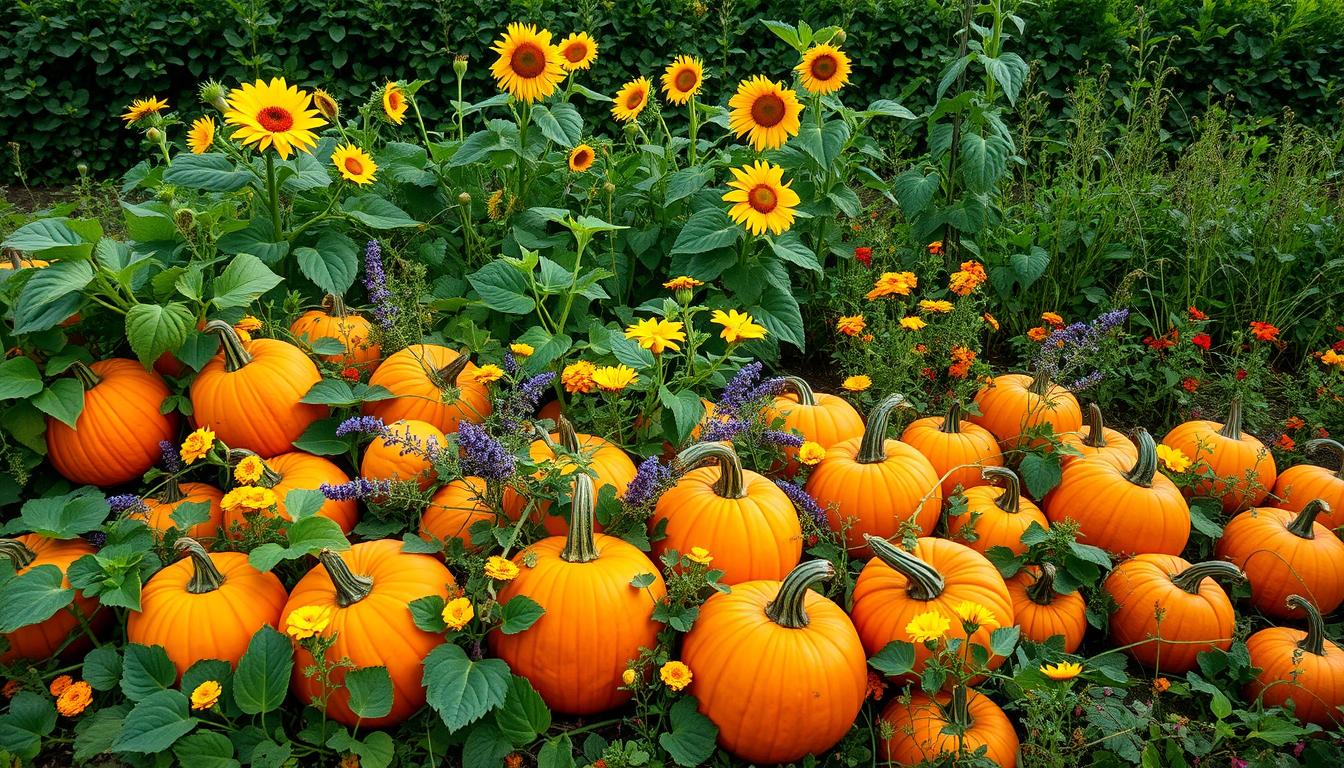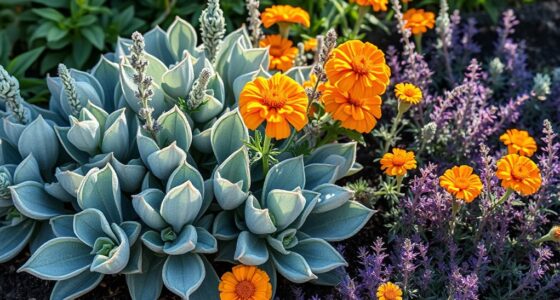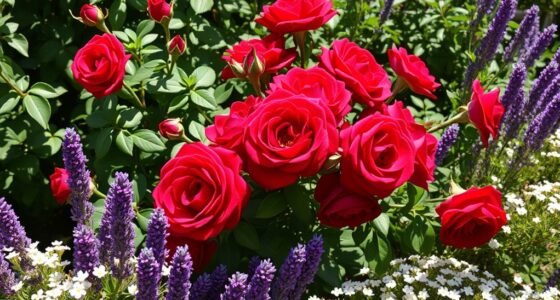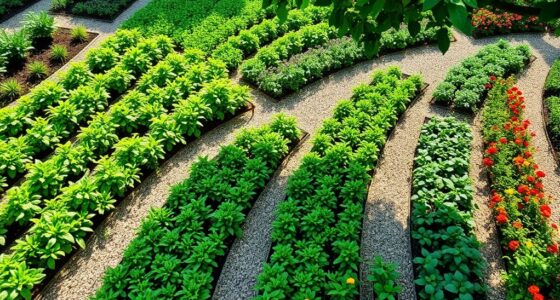Imagine stepping out into your garden, the warm sun kissing your skin and the earthy fragrance of rich soil enveloping you. You pause, taking in the vibrant colors splashed across the landscape. Among them, the cheerful orange of ripe pumpkins stands out, a labor of love nourished by the careful dance of nature and strategy you’ve orchestrated. By embracing pumpkin companion plants, you not only elevate the growth potential of your beloved pumpkins but enhance the overall health of your garden. Let’s explore how these partnerships can transform your gardening experience and help you cultivate the best companion plants for pumpkins.
Key Takeaways
- Discover how companion planting can enhance pumpkin growth.
- Learn about the best companion plants for pumpkins to maximize yield.
- Understand the role of pest management in your gardening strategy.
- Explore effective planting strategies for optimal pumpkin development.
- Gain insights into seasonal considerations for companion plants.
Understanding Companion Planting for Pumpkins
Companion planting plays a significant role in creating a thriving garden, especially when it comes to pumpkins. This technique involves growing compatible plants side by side to enhance growth, deter pests, and improve overall health. By understanding the benefits and principles of companion planting with pumpkins, you can transform your gardening experience.
The Benefits of Companion Planting
Engaging in pumpkin companion planting offers numerous advantages. Not only does it improve soil quality, but it also aids in pest control and boosts pollination. By selecting the right companion plants, you can minimize competition for nutrients and sunlight, while enhancing your garden’s ecosystem. Plants that naturally repel pests help protect pumpkins, inviting beneficial insects to thrive. This harmonious partnership often leads to healthier plants and a bountiful harvest.
How It Works with Pumpkins
The dynamics of companion planting with pumpkins are essential for creating a balanced environment. For instance, pairing pumpkins with nitrogen-fixing plants like beans helps enrich the soil with essential nutrients. These beneficial relationships foster healthier growth, ensuring pumpkins receive adequate support without competing for vital resources. In essence, this method crafts a natural alliance that enhances your garden’s productivity while keeping pests at bay.
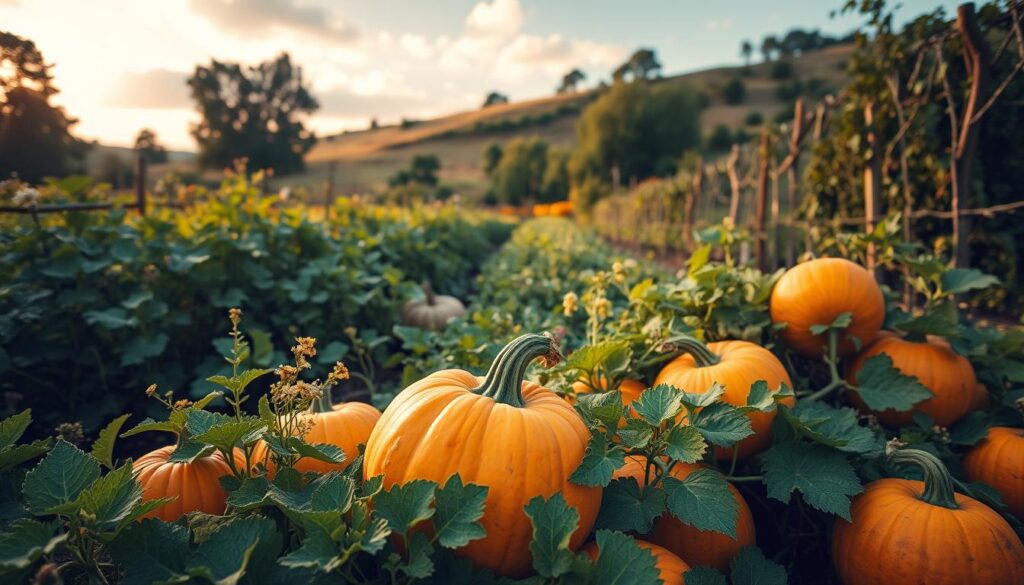
Ideal Companion Plants for Pumpkins
When enhancing your pumpkin garden, selecting the right companions is essential. The synergy between plants can create a thriving environment, where each contributes to the health and growth of the pumpkins. Here are some of the ideal pumpkin companions that can play a significant role in your garden.
Corn: A Natural Support
Corn serves as an excellent support for pumpkin vines. It provides vertical space for pumpkins to climb and creates a shaded area, which can help in regulating temperature and moisture. By including corn in your garden, you foster a beneficial relationship that encourages the health of your pumpkin plants.
Beans: Partners in Nitrogen Fixation
Beans are renowned for their ability to enrich the soil. These plants fix nitrogen, an essential nutrient for pumpkin growth, making them ideal pumpkin companions. Planting beans alongside your pumpkins not only maximizes soil fertility but also enhances overall plant health.
Nasturtiums: Pest Deterrents
Nasturtiums introduce a layer of protection to your pumpkin garden. Their strong scent helps deter pests, which can threaten your pumpkins. By integrating nasturtiums into your pumpkin patch, you create a natural barrier against harmful insects, ensuring healthier plants and a bountiful harvest.
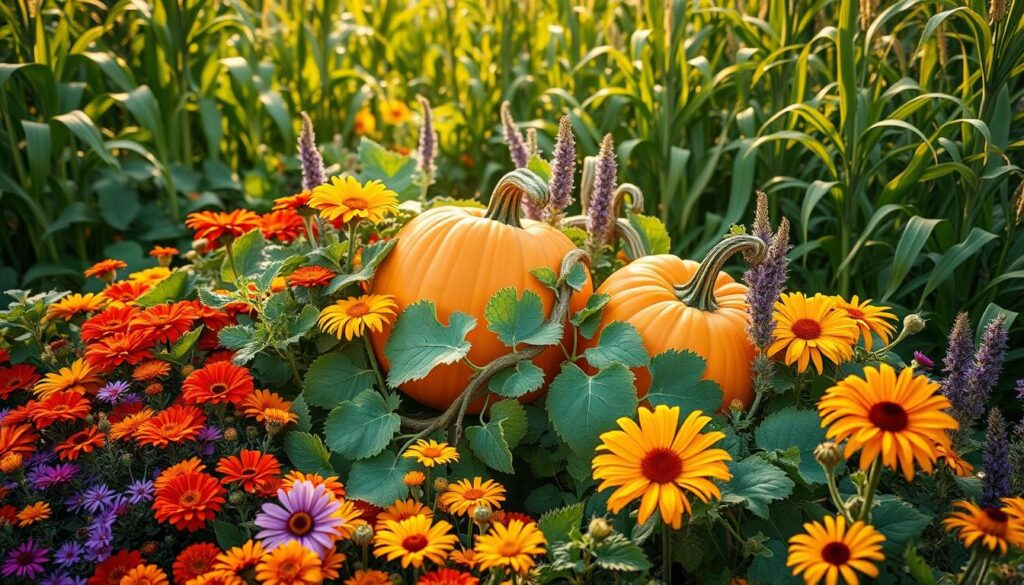
Planting Strategies with Pumpkins
Implementing effective planting strategies is essential for maximizing your pumpkin yield. Consider adopting various intercropping techniques to fully utilize the space in your garden. Proper planning helps you avoid competition for nutrients while enhancing the growth of both pumpkins and their companions.
Intercropping Techniques
One of the best pumpkin interplanting options involves choosing plants that complement each other. For instance, pairing pumpkins with corn or climbing beans takes advantage of vertical space. These companion plants can share the light while allowing pumpkins to spread their leaves, resulting in a productive garden layout.
Spacing for Optimal Growth
Maintaining adequate spacing between plants is crucial. Crowding can lead to stunted growth and competition for vital resources. Allow at least 3 to 4 feet between pumpkin vines and their companions. This ensures that each plant has the room to grow without hindering its neighbors.
Companion Plant Timing
Timing your companion plantings is vital for a successful garden. Aim to plant companions like marigolds and radishes alongside your pumpkins for the best results. Early planting aligns with the growth rates of your pumpkins, maximizing their potential. Not only does this strategy reinforce healthy root systems, but it also encourages robust above-ground growth, leading to a fruitful harvest.
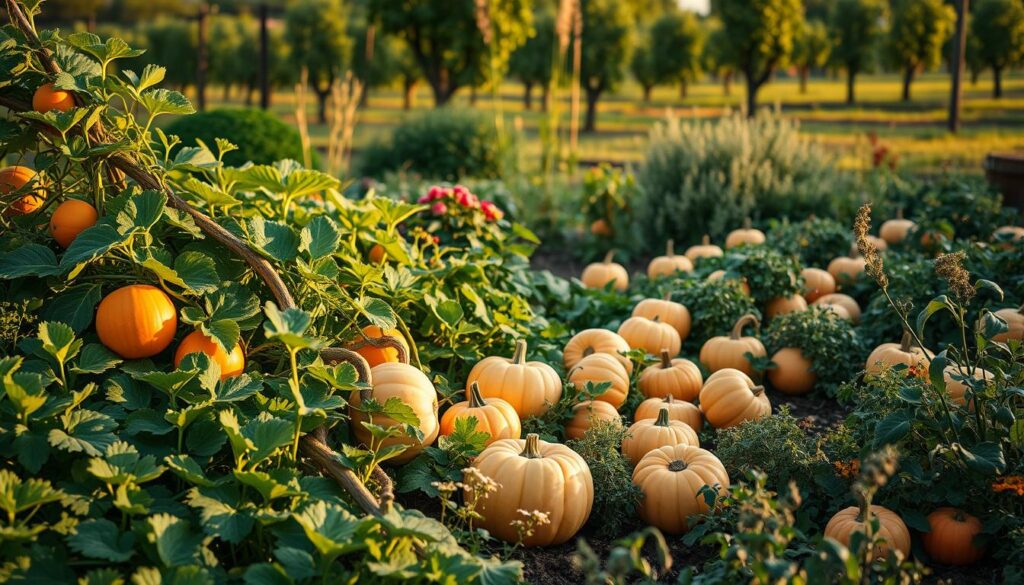
Flowers that Enhance Pumpkin Growth
When considering companion planting ideas for your pumpkins, flowers can play a vital role in boosting growth and health. By choosing the right flowers for pumpkin companions, you create a harmonious garden environment that encourages both beneficial insects and aesthetic beauty. Two standout choices are marigolds and sunflowers, each offering unique benefits that complement pumpkin plants.
Marigolds: Attracting Beneficial Insects
Marigolds are known to be effective companions for pumpkins. These vibrant flowers are not just pleasing to the eye; they also attract beneficial insects like ladybugs and lacewings, which help control harmful pest populations. Furthermore, marigolds emit compounds that can repel pests such as aphids and nematodes, providing a natural shield for your pumpkin plants.
Sunflowers: Adding Height and Beauty
Sunflowers serve as another excellent option for your pumpkin patch. With their towering height and bright blooms, they not only enhance the visual appeal of your garden but also attract an array of pollinators essential for pumpkin flower pollination. The shade provided by sunflowers can create a microclimate that protects both the pumpkins and their fellow companions from excessive sun, promoting healthier growth.
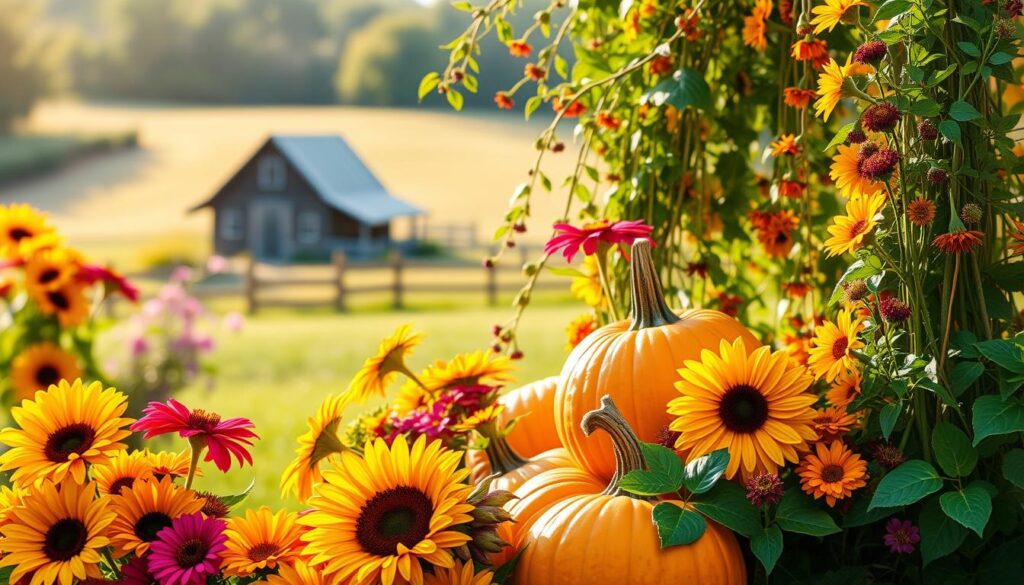
| Flower | Benefits | How It Supports Pumpkins |
|---|---|---|
| Marigolds | Attract beneficial insects, repel pests | Improves pest control, reduces plant stress |
| Sunflowers | Attract pollinators, provide shade | Enhances pollination, shelters pumpkin plants |
By incorporating these flowers for pumpkin companions into your garden, you create a thriving ecosystem that benefits both your pumpkins and their floral partners. Embrace these blooms and watch your garden flourish!
Herbs That Work Well with Pumpkins
Incorporating pumpkin herb companions into your garden can significantly impact the health and yield of your pumpkin plants. Specific herbs not only enhance the flavor of your harvest but also play crucial roles in pest control and attracting beneficial insects.
Basil: Flavor and Pest Control
Basil is a standout among herbs that complement pumpkins. Its aromatic leaves not only add intense flavor to your dishes but also serve as a natural repellant for pests like aphids. Planting basil near your pumpkins can create a beneficial environment, attracting pollinators while keeping harmful insects at bay.
Oregano: Essential Companion
Oregano, with its strong scent, offers another layer of protection for your pumpkin garden. This herb can deter unwanted pests and is known for its adaptability in various garden settings. The presence of oregano helps ensure your pumpkin plants grow healthier and more robust.
By blending these herbs with your pumpkin plants, you will foster a thriving garden ecosystem that contributes to healthier crops, demonstrating the importance of selecting the right pumpkin herb companions.
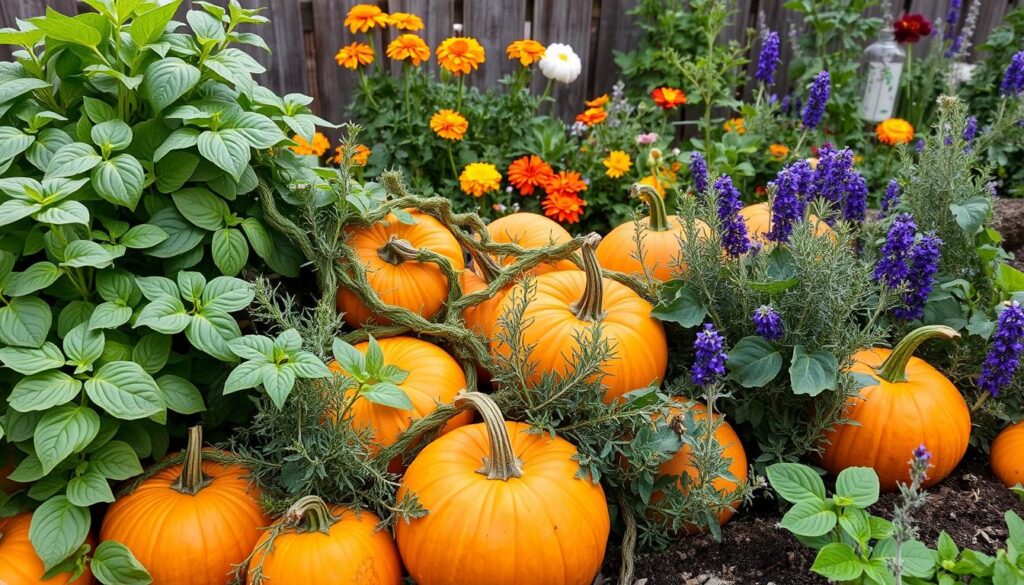
Vegetables to Plant Alongside Pumpkins
Pairing your pumpkins with the right vegetables can enhance growth and maximize your garden space. Selecting compatible pumpkin vegetable companions can yield a thriving garden while ensuring shared nutrients do not create competition. Consider squash and cucumbers, which support pumpkin growth in various ways.
Squash: A Cohesive Family
Squash varieties naturally align with pumpkins in the garden. Both belong to the Cucurbitaceae family, which can lead to successful growth when planted together. Be cautious of potential pest overlaps and nutrient needs. Choosing diverse squash types creates a visually appealing patch and maintains a harmonious garden ecosystem.
Cucumbers: Maximizing Space
Cucumbers serve as excellent companions for pumpkins by optimizing garden space. Their climbing nature allows for vertical growth, saving ground area for your pumpkins. Keep an eye on their nutrient requirements; they are similar to those of pumpkins, ensuring a cohesive growing environment. Proper planning of these best vegetables for pumpkin patches creates a bountiful harvest.
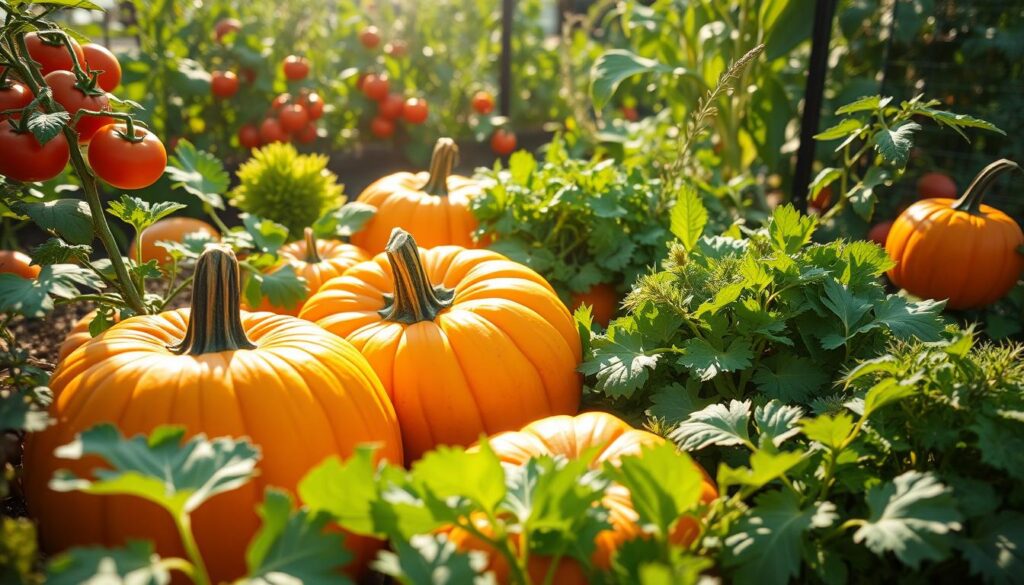
Avoiding Negative Companions for Pumpkins
Understanding the plants to avoid near pumpkins is essential for nurturing a healthy garden. Some crops can hinder pumpkin growth by competing for nutrients and space, leading to suboptimal yields and increased pest problems. Knowing the bad companion plants for pumpkins can significantly influence your planting choices and ensure a more fruitful harvest.
Plants to Keep Away
Certain plants are notorious for their negative impact on pumpkins. For instance, heavy feeders like potatoes and tomatoes can deplete the soil of essential nutrients that pumpkins need for vigorous growth. Other cucurbits, such as cucumbers and squash, might also create competition, leading to smaller fruit sizes and stunted growth.
Recognizing Competing Nutrients
It’s crucial to monitor the nutrient levels in your garden. Plants such as corn may be beneficial in some contexts but can outcompete pumpkins for nitrogen. This competition can result in nutritional imbalances, affecting overall plant health. By understanding which plants to avoid near pumpkins, you can create a harmonious environment that supports these vibrant crops effectively.
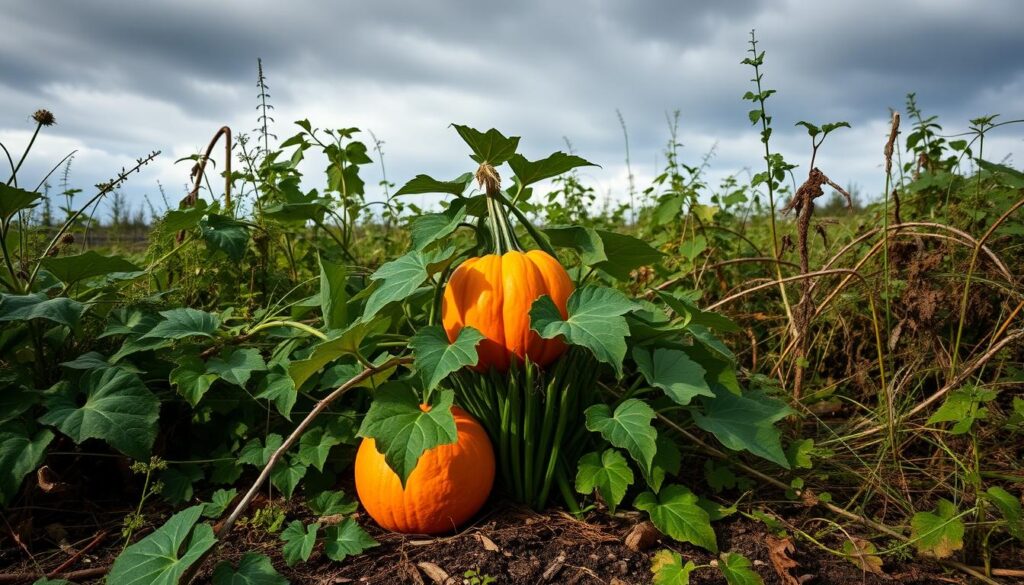
| Plant | Reason to Avoid |
|---|---|
| Potatoes | Heavy feeder competing for nutrients. |
| Tomatoes | Similar nutrient needs that can stress the soil. |
| Cucumbers | Compete closely in growth habits and nutrients. |
| Corn | Can outcompete for nitrogen and space. |
Seasonal Considerations for Planting
When it comes to successful pumpkin gardening, timing plays a crucial role. Understanding the seasonal planting strategies can significantly impact your results. You will find that aligning your planting schedule with the right companions can enhance growth and yield. Familiarity with warm-season companions like corn and sunflowers enables you to make informed decisions that complement pumpkin growing conditions.
Cool vs. Warm Season Companions
Certain plants thrive in specific temperature ranges, making it vital to choose the right companions based on the season. In warmer months, you can pair pumpkins with robust options like corn, beans, or sunflowers. Cool-season companions, such as peas and leafy greens, may also be planted but typically need to be harvested before pumpkins start sprawling. This planning allows for maximizing garden space.
Adjusting for Regional Climate
Your local climate can significantly influence your planting schedule. Knowing your frost dates, summer heat levels, and moisture availability helps tailor seasonal planting strategies to your area. For instance, regions with long growing seasons can accommodate more diverse combinations, while those with shorter windows may require careful selection of faster-maturing companions. Keep these factors in mind to ensure optimal pumpkin growing conditions.
| Region | Frost Date (Approx.) | Recommended Warm-Season Companions | Recommended Cool-Season Companions |
|---|---|---|---|
| North | May 15 | Corn, Sunflowers | Peas, Lettuce |
| Midwest | April 30 | Beans, Corn | Spinach, Radishes |
| South | March 15 | Soybeans, Zucchini | Broccoli, Kale |
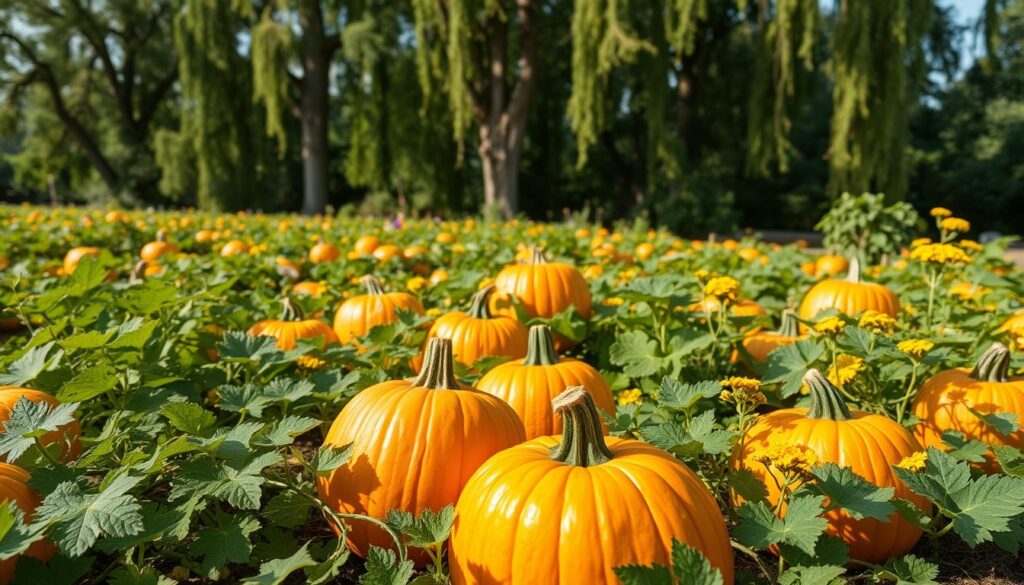
Nutrient Needs for Pumpkins and Companions
Understanding pumpkin soil needs is essential for successful cultivation. Healthy pumpkins begin with nutrient-rich soil that promotes growth and vitality. Employing proper nutrient management for pumpkins significantly enhances your garden’s overall productivity.
Soil Fertility Tips
Enhancing soil fertility can be achieved through various methods. Consider the following practices:
- Composting: Adding well-aged compost improves soil structure and provides essential nutrients.
- Organic Fertilizers: Use organic options like fish emulsion or bone meal to boost nutrient levels without chemical additives.
- Crop Rotation: Rotating crops can prevent nutrient depletion and help maintain soil health.
Organic Options for Nutrient Boost
Incorporating organic amendments is beneficial for soil quality. Leguminous plants act as natural nitrogen fixers, enriching the soil for your pumpkins. The inclusion of cover crops not only protects against erosion but also enhances soil microbial activity, supporting nutrient cycling.
| Organic Amendment | Benefit | Nutrient Contribution |
|---|---|---|
| Compost | Improves soil structure | Nitrogen, Phosphorus, Potassium |
| Bone Meal | Enhances root development | Phosphorus |
| Fish Emulsion | Quick nutrient supply | Nitrogen |
| Leguminous Cover Crops | Natural nitrogen fixation | Nitrogen |
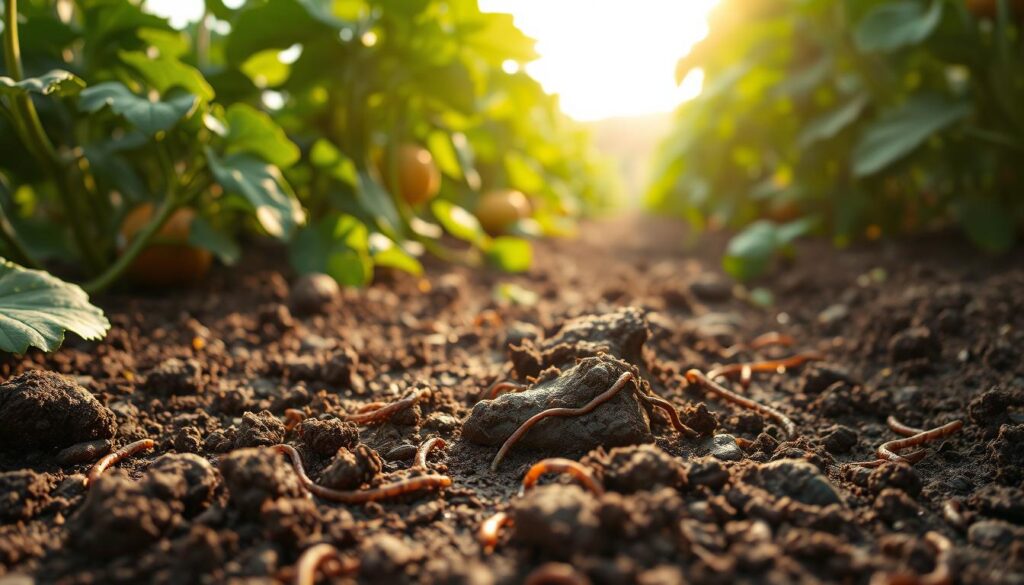
Implementing these strategies ensures that you cater to the distinct pumpkin soil needs while fostering an environment ripe for growth. Prioritizing nutrient management for pumpkins will lead to more robust plants and a bountiful harvest.
Pest Management with Companion Plants
Managing pests effectively is crucial for a thriving pumpkin garden. Utilizing companion plants can shift the balance in pest control for pumpkins, providing a natural approach to safeguarding your crop. By selecting the right herbs and flowers, you can not only protect your pumpkins but also promote a healthier ecosystem in your garden.
Attracting Predatory Insects
Incorporating companion plants like dill and fennel can attract predatory insects, such as ladybugs and lacewings. These beneficial allies feast on common pumpkin pests, helping to keep their populations in check. This balance can reduce the need for synthetic treatments, allowing you to rely on organic methods for pest control.
Natural Repellents in the Garden
Implementing natural insect repellent strategies helps fortify your garden against harmful pests. Flowers such as marigolds produce a scent that deters nematodes and other unwanted species. Borage not only provides a visually appealing option but also exudes qualities that repel pests. By integrating these plants into your pumpkin patch, you create a sustainable barrier against threats that could harm your yield.
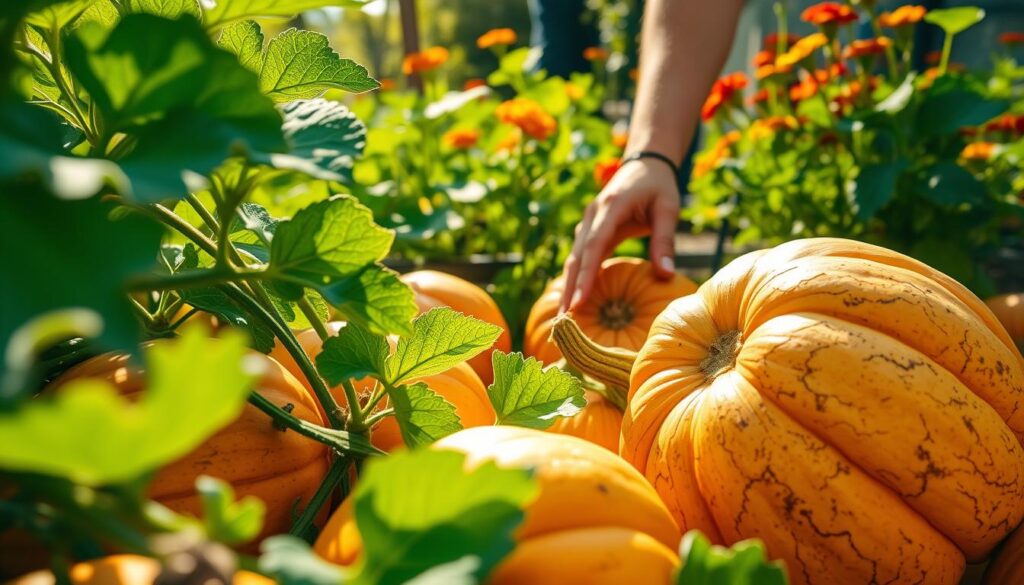
| Beneficial Insect | Accompanying Companion Plant | Pest Targeted |
|---|---|---|
| Ladybug | Dill | Aphids |
| Lacewing | Fennel | Mealybugs |
| Predatory Mite | Chrysanthemum | Spider Mites |
| Parasitic Wasp | Yarrow | Caterpillars |
By embracing these strategies, you’ll cultivate a garden that not only thrives but also becomes self-sustaining in terms of pest management. Investing your efforts into companion planting sets the stage for a successful pumpkin harvest while minimizing issues related to pests.
The Role of Pollinators in Pumpkin Growth
Understanding how pollinators contribute to your garden can greatly enhance your pumpkin harvest. Pollinators for pumpkin growth, such as bees and butterflies, are vital for successful fertilization. Without these creatures, your pumpkin plants may struggle to produce fruit. By engaging in practices that encourage these beneficial insects, you can create a flourishing garden.
Encouraging Bees and Butterflies
Fostering a friendly atmosphere for pollinators involves various strategies. You can start by planting native flowers that bloom at the same time as your pumpkins. This synchronization will help attract beneficial insects to your garden. Some effective flower choices include:
- Lavender
- Echinacea
- Bee Balm
- Zinnias
Avoiding pesticides is equally crucial. Chemicals can harm not only pests but also essential pollinators, disrupting the delicate balance of your eco-system. Embrace natural methods for pest control to maintain a healthy environment for these vital creatures.
Creating a Pollinator-Friendly Garden
Design your garden with specific features that help attract beneficial insects. Include a variety of plants for diverse blooming seasons, ensuring ample food resources throughout the growing period. Providing nesting areas such as undisturbed soil or patches of tall grass will encourage local bees and butterflies to settle in. Incorporating water sources, such as shallow dishes with stones, can support these insects, attracting them to your space.

By investing time in creating a pollinator-friendly garden, you increase the chances of higher yields and healthier plants. The symbiotic relationship between your pumpkins and these pollinators not only boosts your gardening success but also contributes to the surrounding ecosystem.
Harvesting and Caring for Your Companions
Harvest timing for pumpkins plays a significant role in the flavor and nutrition of your produce. Understanding when to collect your pumpkins ensures they are at their tastiest while making room for companion plants to thrive. Once you’ve completed the harvest, focusing on post-harvest care for companion plants enriches your soil, preparing it for future planting cycles.
Timing Your Harvests
To determine the ideal moment for harvesting pumpkins, observe the color and firmness of the skin. The true signs of ripeness include a deep, vibrant color and a tough skin that resists puncture. Harvesting can typically occur in the fall, closer to the first frost, as long as the pumpkins have reached full size.
Maintaining Companion Plants Post-Harvest
After harvesting, it’s essential to attend to your companion plants. Regular inspection allows for early pest detection and promotes overall plant health. Implement practices such as:
- Pruning dead or damaged leaves to encourage new growth.
- Applying organic compost to enrich the soil.
- Watering according to seasonal needs to maintain soil moisture.
By committing to thoughtful post-harvest care for companion plants, you can enhance soil quality and promote beneficial insect activity, ultimately leading to a more fruitful garden in the upcoming growing season.
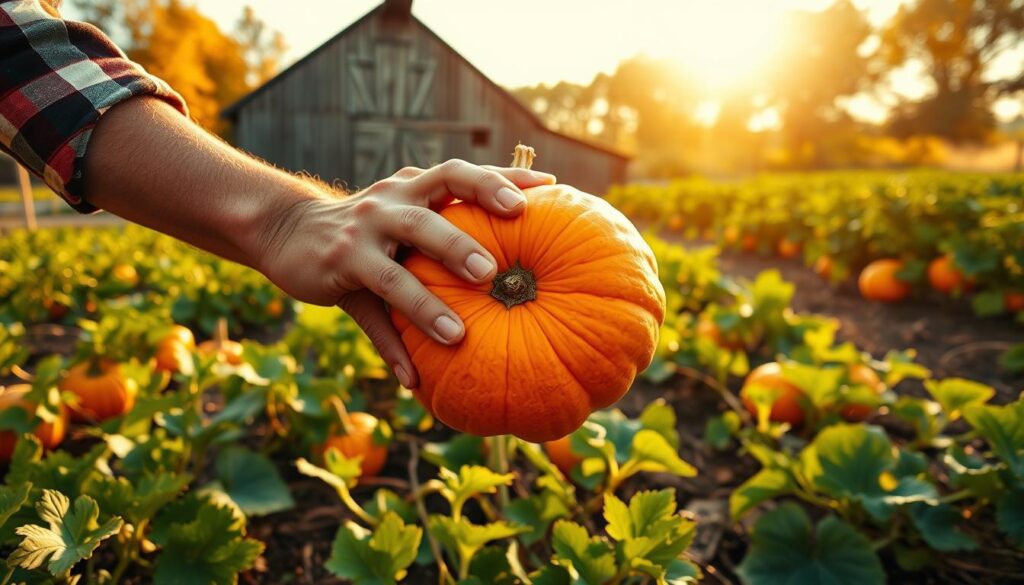
Real-Life Success Stories
Exploring real-life gardening experiences provides a treasure trove of knowledge about the art of companion planting. These successful gardening stories showcase how individuals transform their plots and achieve bountiful harvests through thoughtful plant partnerships.
Community Gardens Embracing Companion Planting
Community gardens across the nation have become vibrant examples of how pumpkin companion planting examples can lead to flourishing ecosystems. In various neighborhoods, groups of gardeners have teamed up to optimize their space by pairing pumpkins with corn and beans. This approach not only creates a supportive environment but also boosts productivity, making the most of limited resources.
Home Garden Examples
Home gardeners have shared inspiring tales regarding companion planting with pumpkins. Many have found that growing nasturtiums alongside pumpkins not only deters pests but also adds beauty to the garden. Their successful gardening stories highlight specific plant pairings like white and orange pumpkins combined with vibrant marigolds, resulting in visually appealing and productive gardens.
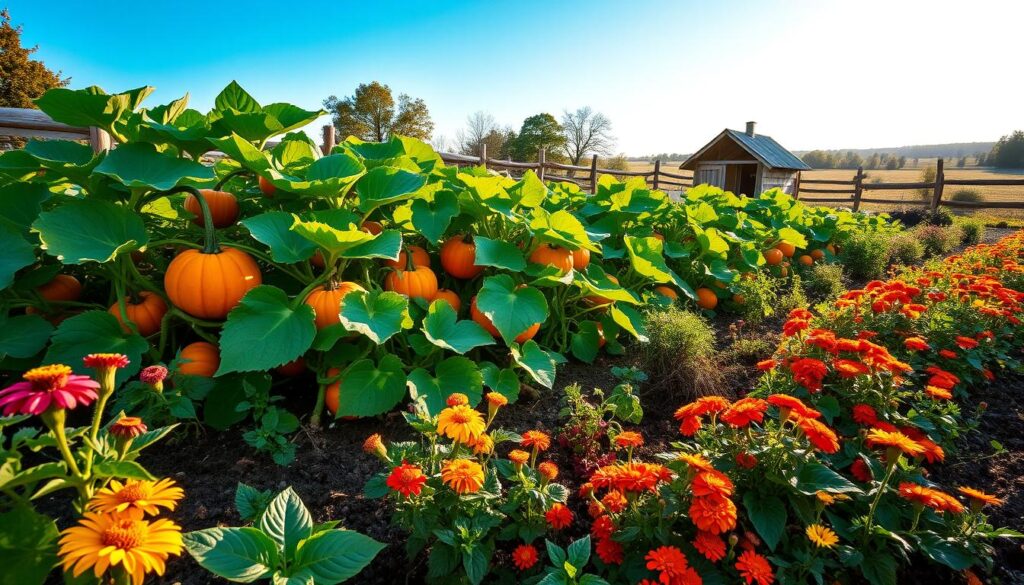
Final Tips for Perfect Pumpkin Companions
As you embark on your journey into pumpkin companion planting, it’s essential to summarize the key points that can enhance your garden’s productivity. Understanding the importance of planting suitable companions, from herbs and flowers to other vegetables, can uplift your pumpkin patch significantly. Utilizing the pumpkin companion planting guide throughout the growing season will help you make informed decisions about which plants benefit most from each other. From marigolds that attract beneficial insects to beans that enrich soil nitrogen, the right combinations can create a thriving gardening ecosystem.
Now that you are equipped with best practices for plant companions, consider how your unique garden conditions can influence these pairings. Experimentation is key. Each garden is different, and factors like sunlight, soil type, and local climate can drastically affect plant relationships. Don’t hesitate to try out various combinations to discover what truly flourishes in your space. Learning through trial and error can lead to unexpected successes and new favorites.
In conclusion, by integrating the diverse elements discussed in this article, you can maximize your pumpkin yield while enjoying the process of gardening. Whether you’re a novice or a seasoned gardener, applying these insights will guide you towards a lush, bountiful pumpkin harvest. Embrace the spirit of trial and exploration—your garden’s potential awaits!
